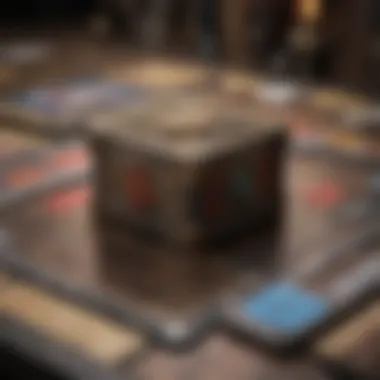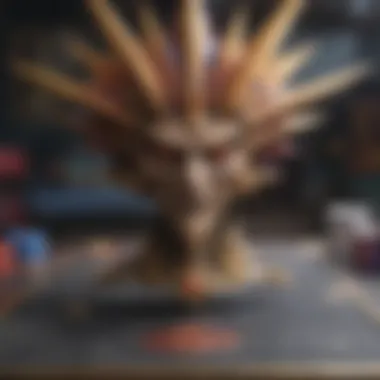Mastering the Art of Yu-Gi-Oh: A Complete Guide


Intro
Yu-Gi-Oh is more than just a card game; it is a complex and strategically rich experience that blends creativity with tactical play. This article aims to uncover the core mechanics that define how to effectively engage in Yu-Gi-Oh. Whether one is a newcomer drawn to its captivating universe or an experienced duelist seeking to refine strategies, understanding the game's rules and components is crucial.
With a variety of card types—Monster, Spell, and Trap—each player must learn how to leverage these elements to their advantage. Deck building is an essential skill, influencing not just the individual’s chances of winning but also the overall enjoyment of the game. Our exploration will also extend to the duel tactics that can turn the tide of a game, offering insights into crisis management and opponent prediction.
This guide will also delve into the various formats in which Yu-Gi-Oh can be played. From casual games among friends to competitive tournaments, each setting offers different challenges and opportunities for strategy. By the end of this article, readers will have a comprehensive overview of how to engage with Yu-Gi-Oh, making informed decisions that enhance their gameplay and enjoyment.
Intro to Yu-Gi-Oh
Understanding Yu-Gi-Oh is vital for anyone seeking to engage with this complex and stimulating card game. It is more than just a game; it represents a blend of strategic thinking and competitive spirit. Yu-Gi-Oh has a dedicated following, making it essential to grasp its core concepts, rules, and historical context.
This section will cover the basic elements of the game, from its overview to its historical roots. By grasping these foundations, players can appreciate the depth and creativity that Yu-Gi-Oh offers and can begin to develop strategies that enhance their gameplay experience. Whether you are a newcomer eager to learn or a seasoned player looking to refine your skills, understanding the introductory aspects of Yu-Gi-Oh will better prepare you for the diverse challenges within this game.
Game Overview
Yu-Gi-Oh is a trading card game that focuses on strategic duel battles between players. Participants use custom decks of cards to summon powerful monsters, cast spells, and set traps in order to deplete their opponent’s life points to zero. The gameplay involves making tactical decisions not only in the structure of one’s deck but also during the course of a duel. The game includes various card types: monsters, spells, and traps, each serving a unique role in battles.
Familiarity with the game mechanics is crucial for success. Players must understand how to play their cards effectively while anticipating their opponents' moves. Yu-Gi-Oh is unique in that it allows for a significant level of customization and personal expression through deck building. Each duel can provide a new experience due to variable strategies and card combinations.
Brief History of the Game
The origins of Yu-Gi-Oh trace back to the manga series created by Kazuki Takahashi, which was first published in 1996. The success of the manga led to the launch of a trading card game in 1999. The game quickly became popular not only in Japan but also globally, becoming a staple in collectable card gaming.
Through the years, Yu-Gi-Oh has evolved. New card sets and rules have been introduced regularly, keeping the game fresh and engaging. The competitive scene grew as well, with local and international tournaments attracting players of all skill levels. This evolution continues to attract new players while sustaining interest in veteran players. The game's rich lore and character connections from the anime and manga also enhance its appeal.
Basic Rules of Play
Understanding the basic rules of play is fundamental in grasping Yu-Gi-Oh. This section lays the groundwork for newcomers and offers a refresher for experienced players. The rules govern how the game is conducted, ensuring fairness and structure. Learners begin to appreciate strategy, timing, and decision-making as they navigate through the mechanics. These elements ultimately enhance the experience of playing Yu-Gi-Oh.
Understanding Turns
Every duel in Yu-Gi-Oh progresses in turns. A typical turn is composed of several phases. The order of these phases is critical, impacting gameplay outcomes significantly. Here are the phases involved in a turn:
- Draw Phase: Players draw one card from their deck.
- Standby Phase: Actions that occur once both players have drawn are resolved here.
- Main Phase 1: Players can summon monsters and activate spells or traps.
- Battle Phase: Players may attack their opponent's monsters or their life points directly.
- Main Phase 2: Similar to Main Phase 1, where additional actions can be taken before ending the turn.
- End Phase: All effects that express 'until the end of the turn' are resolved.
Understanding each of these phases allows players to optimize their strategies during gameplay. Decisions made in one phase can carry over into the next, making it essential to think ahead.
Winning Conditions
Winning a duel in Yu-Gi-Oh can be accomplished in several ways, each requiring different strategies and card combinations:
- Reduce Opponent's Life Points to Zero: This is the most common and straightforward win condition. Players attack directly, whittling down an opponent's life points.
- Deck Out: If a player draws a card when their deck is empty, they lose the game. Thus, managing both decks and card draws is crucial to avoid this.
- Special Card Effects: Certain cards have unique win conditions that may end the duel immediately when specific criteria are met. Examples include "Exodia" cards and "Final Countdown."
Knowing these conditions shapes how players approach a duel, prompting them to balance offense and defense while also keeping in mind possible victory methods.
Card Types in Yu-Gi-Oh
Monsters
Monsters are the backbone of a Yu-Gi-Oh deck. They are necessary for offensive capabilities and control over the duel.
Attributes and Levels
The attributes and levels of monster cards dictate their strength and abilities. Each monster has an elemental attribute like Fire or Water and a level that indicates its power. Higher-level monsters typically have greater attack and defense points. This characteristic makes them an essential choice for building a competitive strategy. For example, a Level 4 monster can be summoned without any sacrifices, while Level 5 and above require the player to tribute other monsters to summon them. However, relying solely on higher-level monsters can lead to difficulties in getting them onto the field efficiently, leading to potential disadvantages in play.
Types of Monsters
There are various types of monsters, such as Warrior, Spellcaster, and Dragon. Each type often has specific synergies with various cards. For instance, Dragon-type monsters are known for their powerful effects and high attack. Choosing the right type based on one's strategy is important; it allows players to leverage strengths and utilize unique features. However, focusing too much on a single type can limit deck diversity and options, thus presenting a risk in evolving gameplay.
Spells


Spell cards serve versatile roles in enhancing gameplay. They can directly influence the state of the game and assist in achieving victory.
Types of Spell Cards
There are different types of spell cards, including Normal, Quick-Play, and Continuous spells. Each serves a distinct purpose in a duel. For instance, Quick-Play spells can be activated during either player's turn, making them a strategic option for unexpected moves. This versatility is beneficial as it provides players with options to counter their opponents. Nevertheless, relying too heavily on certain types of spells may lead to unfavorable situations when facing a well-rounded opponent.
Usage in Gameplay
The usage in gameplay of spell cards is vital for executing tactics and strategies. Players might use destructive spells to remove enemy monsters or defensive spells to protect their own. Knowing when to play these cards can dramatically shift the tide of a match. The key characteristic is their ability to be proactive or reactive based on the state of the game. However, maintaining a balance and understanding the timing for each card is crucial, as playing them at the wrong moment can waste valuable resources.
Traps
Trap cards are strategic elements that add depth to a player's defense and counterplay activities. They are essential for protecting life points and disrupting an opponent's strategies.
Types of Traps
Trap cards include Normal, Continuous, and Counter traps. Each type has different requirements and effects. For example, Counter traps are especially pivotal because they can negate spell or monster effects. This feature provides significant control over the game. While they can be invaluable, their reliance on the opponent's actions means they can sometimes be ineffective if not timed correctly.
Strategic Implementation
The strategic implementation of trap cards can turn the tide in a duel. Players utilize traps to trick adversaries and protect themselves from threats. Understanding the opponent's strategy allows for better timing in activating traps, providing defensive strength. However, if traps are overused or poorly managed, they can hinder a player's overall strategy, leading to vulnerabilities.
"Understanding card types and their strategic usage enriches gameplay and enhances chances of winning in Yu-Gi-Oh."
Deck Building Fundamentals
In Yu-Gi-Oh, the way you build your deck plays a critical role in your overall success during duels. The right combination of cards can enhance your performance, increasing the odds of victory against opponents. Deck building is not just about choosing cards you like; it requires a thoughtful approach that considers various elements, benefits, and key strategies.
Constructing a Competitive Deck
When constructing a competitive deck, players should start with a clear strategy. Identify the goal of your deck. Will it focus on aggression, control, or a mix of both? After setting your objective, select cards that align with this direction. Cards should complement each other, enabling combos and enhancing synergy. A competitive deck usually consists of 40 to 60 cards, including monsters, spells, and traps.
Essential points to consider include:
- Top Tier Cards: Choose cards that have proven effective in tournaments. These often have strong stats or useful effects.
- Consistency: Ensure your deck can draw the key cards effectively, through card draw effects or recycling.
- Adaptability: Include cards that can adjust based on your opponent's strategy.
Following these principles can help create a deck that performs consistently well.
Synergy Among Cards
Card synergy is the harmonious interaction between cards in your deck that enhances performance. Selecting cards that work well together increases your chances of executing powerful combinations. It is important to understand individual card effects and how they relate to others in your deck.
- Example of Synergy: If you use a card like "Dark World Dealings", it allows you to draw a card while discarding another. Pair it with monsters like "Grapha, Dragon Lord of Dark World" that benefit from being discarded.
Having synergy means your deck is not just a collection of strong cards; it becomes a well-oiled machine, making strategies more effective in any duel.
Balancing Card Types
A well-rounded Yu-Gi-Oh deck must balance different card types: monster, spell, and trap cards. Each type serves a unique purpose in your strategy. A common approach is to use about 20 monsters, 10 spells, and 10 traps as a starting point. Adjust these numbers based on your specific deck strategy or the meta game.
- Monsters: They are the primary source of attacking and defending. Focus on their effects and attributes.
- Spells: Use these for support and disruption. They can strengthen your monsters or limit your opponent’s plays.
- Traps: Defensive cards that can counteract your opponent’s moves. They require careful timing to maximize their effectiveness.
Balancing these card types is essential to ensure your deck is flexible and can address varied gameplay scenarios.
In summary, deck building in Yu-Gi-Oh is a carefully crafted art that involves strategy, synergy, and balance among card types. By applying these principles, players can create competitive decks that stand up to challenges from other skilled duelists.
Dueling Strategies
Dueling strategies are essential in Yu-Gi-Oh, guiding players in how to approach battles effectively. They encompass various techniques, including offensive and defensive plays, and the ability to read an opponent's moves. By mastering these strategies, players improve their overall performance in duels. Understanding each aspect enables a player to adapt to different scenarios, making them be more flexible and strategic in their gameplay.
Offensive Strategies


Offensive strategies are crucial for gaining the upper hand in battles. These strategies focus on dealing damage to the opponent’s Life Points as quickly as possible. Players should prioritize the use of high-attack monster cards to pressure opponents. Combining monster effects with powerful spell cards can create significant bursts of damage.
In addition, players can benefit from cards that allow them to conduct multiple summons. This tactic can overwhelm an opponent, making it difficult for them to defend. Here are some tips for effective offensive strategies:
- Identify key cards. Knowing which cards to include that can hit hard quickly helps.
- Consider synergy. Choose monsters and spells that work well together.
- Calculate risk. Sometimes, aggressive plays can leave you vulnerable. Plan moves carefully.
Defensive Strategies
Defensive strategies are just as important as offensive ones. While attacking is vital, protecting your Life Points can often mean the difference between winning or losing. Players should incorporate trap cards and spells that can negate attacks or prevent damage.
Moreover, it is wise to summon monsters with strong defense points to absorb incoming damage. Defensive play can buy time, allowing you to build up a stronger field. Here are strategies for better defense:
- Use trap cards wisely. Timing is everything in choosing when to activate traps.
- Know your opponent’s deck. Understanding the common threats allows for better preparation.
- Maintain card advantage. Keeping more cards in hand can provide options in tricky situations.
Reading Opponents' Moves
Reading opponents' moves is a subtle yet powerful skill in Yu-Gi-Oh. Understanding your opponent’s intentions can help you counter their strategies before they unfold. To achieve this, observe their play style, which might reveal tendencies—whether they favor aggressive tactics or prefer control.
Players should also consider the cards that their opponents have played and those they are possibly holding. Anticipating moves allows you to effectively preempt actions, making defensive or reactive play more effective.
To improve this skill, players can:
- Keep track of played cards. Knowing what has been placed can aid in making informed decisions.
- Watch for patterns. Recognizing repetition in your opponent's strategy can provide insights into their future plays.
- Adjust on the fly. Be flexible in your strategy based on how your opponent is playing.
Mastering both offensive and defensive strategies, as well as reading your opponent, is vital for excelling in Yu-Gi-Oh. Being responsive and adaptable creates a dynamic gameplay experience.
Advanced Gameplay Techniques
In the realm of Yu-Gi-Oh, advanced gameplay techniques are crucial for players who wish to elevate their skills and enhance their competitiveness. These tactics go beyond basic rules and strategies, adding depth to the gameplay experience. Understanding these techniques can give players a significant edge in both casual and tournament settings. By mastering advanced tactics such as chain links and combos, players can manipulate the flow of the duel and increase their chances of victory. The benefits of these techniques are clear: they allow for more strategic plays, create opportunities to outsmart opponents, and deepen the overall engagement with the game.
Chain Links
Chain links play a significant role in advanced gameplay. They represent a sequence of actions and responses that can dramatically alter the outcome of a duel. When a player activates a card or effect, it is often necessary for opponents to respond or react. This creates a chain, where each action is dependent on the previous one. Understanding how chain links function is essential for players seeking to maximize their tactical options.
Some key points to consider about chain links include:
- Priority: Players need to know which player has the priority to act first. This can be a turning point in gameplay.
- Responding: Being able to counter or enhance effects is what makes chain links powerful. Knowing the right moments to respond can gain an upper hand.
- Timing: The sequence in which responses occur can lead to unexpected outcomes. Timing your actions strategically can catch opponents off guard.
For example, if a player activates a spell card, the opponent may respond with a trap card. This becomes a chain link that both players must navigate, making their choices carefully. The skillful use of chain links can turn the tide of the game.
Combos
Combos are another vital component of advanced gameplay in Yu-Gi-Oh. They involve combining multiple cards or effects in a way that produces a more potent result than using each card individually. Creating effective combos requires an in-depth knowledge of one's deck and an understanding of how different cards interact with each other.
Here are some tips for developing combos:
- Card Synergy: Choose cards that enhance each other. Some cards work best when played together, creating a powerful effect.
- Sequencing: The order in which cards are played can maximize the benefits. Sequence your plays carefully to generate the most advantage.
- Flexibility: Successful combos often adapt based on the opponent's moves. Being flexible can create new opportunities mid-duel.
One example of a successful combo might involve summoning a strong monster followed by a spell that boosts its attack power. By combining these elements effectively, a player can deliver significant damage in a single turn.
In summary, advanced gameplay techniques like chain links and combos are fundamental for players aiming to become more proficient in Yu-Gi-Oh. Mastery of these techniques enhances strategic depth and can lead to greater success in duels.
Formats of Play
In the realm of Yu-Gi-Oh, understanding the different formats of play is vital for an enriching experience. These formats dictate how the game is played, including card limitations, deck building strategies, and the overall flow of matches. Players should consider their preferences and objectives as they choose a format, whether it be for competition, casual engagement, or even nostalgia. Each format presents unique opportunities and challenges that can significantly impact gameplay.
Traditional Format
In the Traditional Format, players can use nearly any card available in the Yu-Gi-Oh universe. This offers a wide array of strategies, but it also poses the risk of overpowered cards dominating play. One notable aspect of this format is the lack of a limit on the number of copies of any given card, which can lead to the creation of decks centered around a few exceptionally powerful cards.
- Key Features:


- No restrictions on card variety.
- Players can form decks using older and harder-to-find cards.
- Strategic depth is heightened as players exploit strong combos without constraints.
A drawback of this format might be that balance can become an issue, requiring players to adapt and counter widely used strategies.
Advanced Format
The Advanced Format introduces a structured approach that incorporates regulations to ensure balance among players. In this format, each deck is required to adhere to specific card limits, including bans on certain cards deemed too powerful. This format levels the playing field, encouraging more diverse deck building and strategies.
- Benefits:
- Promotes balanced gameplay.
- Reduces prevalence of overwhelming decks.
- Encourages creativity in deck construction, as players must work within limitations.
This format is often favored in sanctioned tournaments and competitive play, allowing players to engage on fair terms.
Casual Play
Casual Play is an informal format where the rules can be adjusted based on players' preferences. This format is about enjoyment rather than strict adherence to competitive standards. It allows players to experiment with unique decks and play styles without concern for regulations.
- Characteristics:
- Flexible rules.
- Emphasis on fun and interaction rather than competition.
- Ideal for sharing the game with friends or newcomers.
Casual play can be a great way to cultivate a love for the game, especially for those who are just starting to delve into the world of Yu-Gi-Oh. It can encourage experimentation and foster a supportive environment for growth.
Engaging with different formats of play enhances your understanding and enjoyment of Yu-Gi-Oh, offering insights into the strategic elements that define the game.
Resources for Players
In the realm of Yu-Gi-Oh, having the right resources enhances the gaming experience significantly. These resources provide players with tools, information, and community support necessary for mastering the game. By engaging with online platforms, participating in tournaments, and utilizing learning materials, players can deepen their understanding and elevate their gameplay.
Online Communities
Online communities play a crucial role for Yu-Gi-Oh players. They act as hubs where enthusiasts gather to share strategies, discuss card combinations, and connect with others who share a passion for the game. Platforms like Reddit offer dedicated threads for strategies and deck discussions, while Facebook hosts various groups where players can seek advice or showcase their latest decks.
The benefits of these communities include:
- Immediate Feedback: Players can quickly post their decks and receive constructive criticism.
- Networking: Meeting other players can lead to local gaming opportunities or even friendships.
- Updates on Meta: Staying informed about the current game trends can give players an edge in competitive play.
Tournaments and Events
Participating in tournaments and events is essential for any dedicated Yu-Gi-Oh player. Tournaments provide an arena to test skills against other players. They often feature different formats, allowing for diverse strategies and adaptations. Events can range from local gatherings at hobby shops to large-scale competitions attracting players from all regions.
Key points about attending these events include:
- Competitive Experience: Facing varied opponents sharpens strategic thinking.
- Prizes: Many tournaments offer cards, merchandise, or cash as incentives, adding motivation for participation.
- Skill Development: Competing helps players learn through experience, analyzing their own and others' play styles.
"Tournaments not only test your knowledge but also build your confidence as a player."
Learning Materials
Learning materials are invaluable for both newcomers and seasoned players. Books, online tutorials, and videos provide insights that can be missed in casual play. Resources like instructional videos on YouTube help players visualize complex strategies, while websites like Wikipedia and Britannica can serve as glossaries for terminology.
Some recommended learning materials are:
- Strategy Guides: Books that detail advanced strategies and deck-building techniques.
- YouTube Channels: Channels focused on gameplay walkthroughs and card reviews.
- Official Rulebooks: Understanding the latest rule updates is critical for compliance in play.
By utilizing these resources, players can refine their skills and engage more fully in the world of Yu-Gi-Oh.
Finale
The conclusion of this article serves as a crucial summary of key points discussed regarding Yu-Gi-Oh. It encapsulates thoughts on gameplay, deck building, and strategies, emphasizing their significance in enhancing a player’s performance.
Reflection on the Game
Reflecting on the game, Yu-Gi-Oh is much more than a simple card game. It requires analytical thinking, strategic planning, and adaptability. Players often experience a personal growth journey as they learn to navigate complex rulings and develop their own unique styles of play. The rich lore behind the cards and characters, combined with the competitive nature of dueling, keeps the game engaging. Moreover, the sense of community among players fosters an environment of shared knowledge and friendship. Players share strategies and insights through online forums like Reddit, elevating the overall gameplay experience.
Future of Yu-Gi-Oh
Looking toward the future of Yu-Gi-Oh, the game continues to evolve. New card sets are frequently introduced, thereby expanding the possibilities and strategies available. The integration of technology and digital platforms for gameplay and tournaments suggests a trend toward increased accessibility. There is also a growing inclination toward inclusivity, welcoming players of all ages and backgrounds. Whether a newcomer or veteran, the future promises an engaging and dynamic environment within the world of Yu-Gi-Oh. Players should remain attuned to updates and changes, as staying informed enriches their gameplay experience.



